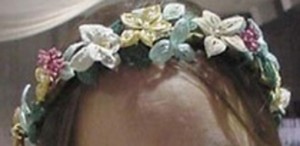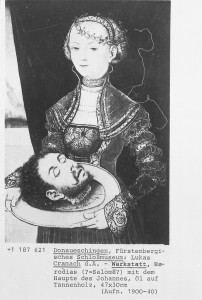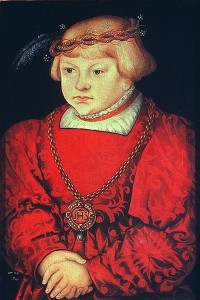 hot houses, green houses, and the idea that bulbs could be forced, natural flowers could only be had for the short time they were actually in season. Jeweled flowers, and those of gold and other precious metals, have survived the ravages of time and are well represented in paintings. Silk flowers from the fifteenth and sixteenth centuries still survive and, while quite rare, there are some surviving flowers made from beads. Dried flowers were also popular but they certainly didn’t hold up well to daily use. Circlets, along with garlands, wreaths, and coronals, were incredibly popular from the twelfth century through the seventeenth century in some areas. In Germany, more so than anywhere else, floral ornaments and designs seemed to have been preferred over everything else.
hot houses, green houses, and the idea that bulbs could be forced, natural flowers could only be had for the short time they were actually in season. Jeweled flowers, and those of gold and other precious metals, have survived the ravages of time and are well represented in paintings. Silk flowers from the fifteenth and sixteenth centuries still survive and, while quite rare, there are some surviving flowers made from beads. Dried flowers were also popular but they certainly didn’t hold up well to daily use. Circlets, along with garlands, wreaths, and coronals, were incredibly popular from the twelfth century through the seventeenth century in some areas. In Germany, more so than anywhere else, floral ornaments and designs seemed to have been preferred over everything else.

The privileged could afford the very best. In Sicily there was recorded a silk cayula, a sort of coif, “with its little coronal of gold and little leaves.”1 The 1380 inventory of Charles V of France lists a less costly coif “composed of a network of 409 gold wires, set with 100 red stones and 141 clusters of pearls, each cluster set on a pair of poppies.”2 The same can be seen in sixteenth century German woodcuts where womens headdresses are floral in appearance.3 In 1474 we find Gabrielle, Comtette de Montpensier had two coifs “one of plain gold wire and the other of gold wire shaped to make roses.”4
Pliny reports garlands of artificial flowers, made of very thin sheets of horn, and colored. Later, silk was used, and even thin gold and silver leaf. The Virgins crown may be a very elaborate goldsmiths work, with jewels in it, or a wreath, or a halo that Christ is apparently causing to shine forth for the first time.5
It was the French though who were making chaplets, most for statues of the divine. The nuns spent a great deal of energy dressing little statues of the Christ child for devotional exercises and some of these contain simple flowers.
I first became interested in making a chaplet of silk flowers after I had done one in beads. Silk flowers are better represented in the history books and I had two wonderful pieces (pictures) to work from. The first is a small picture of the Kunigunde reliquary crown which is compossed of silk, beads, and wire (amoung other things) and the other was a picture of silk twisted wire from the book Dress Accessories.
I first learned how to make silk flowers just a few months ago. From what I could find out there is more than one way to create silk flowers. One form is called Kloisterarbeiten and the other is called Ganutell. There are probably more but these are the two I am aware of. This circlet is made using the Ganutell form.
Ganutell is said to be native to Malta and date back to the 16th century. I’m not sure that’s true but it doesn’t contridict anything else I’ve found. The method of wrapping the wire and the silk floss is the same (at least the same end result) as that found on fourteenth century artifacts from England. The flowers look, in the end, to be made in the same fashion as those found on the Kunigunde reliquary crown. (The flowers could be made of beads or silk wrapped wire – either way its the same technique when it comes to making the flowers.)
Each petal was created separately until I had approximately 40, enough to give coverage all the way around. Then I created enough flowers to spread them out around the circlet. The circlet itself is a base of 12 gauge iron wire (very available throughout the middle ages) wrapped around my head 2 1/4 times leaving about a half inch of space. The reason for this is two wires lightly twisted will keep the whole garland from rotating and makes it more steady. The reason for the extra room is because of the extra wires that will get woven in (the final fit is very good). Each leaf has a tail of four wires and all of these wires were then woven or braided around the wire base. After all the parts were in place, I wrapped the wires in floral tape though the period method would have been ribbon or silk thread I opted for floral tape because I could get better coverage that would hold up longer and to more constant wear (plus it is water and sweat proof so the wire won’t rust) and it is out of view so doesn’t distract.
The silk is Soie d’Alger from Kreinik. I bought a variety pack of colors in 2.5 meter lengths. Wire for the flowers range in size from 19 to 34 gauge. The finest gauges (30 and 34) are twisted with the silk by first cutting the silk and wire into equal lengths and then tieing the ends off and securing one end to something that won’t move (which varied from the knob on a drawer to a sissors being held by a friend). At this point you just twist. The quickest way it to get a hand drill with a cup hook attachment. I did discover (when I forgot said tool) that it can be done manually. I tied a four foot length to a small sissors and held it firmly by standing on it. the other end I tied to a pencil and just twirled it in my hand. Be sure to keep the silk and wire taunt while its being twisted. When its tight enough tie another knot at each end to keep it from untwisting. Proceed with making petals, remembering to tie a knot in the silk wrapped wire before cutting it!
The petals are each made using a heavier wire as a base. I had the thought that the process of wrapping a petal is exactly the same as making a “God’s Eye” – something most kids do at summer camp. Petals generally have one center line (rather than a cross) which requires the lacing thread to be stiff enough to hold its shape whereas a God’s Eye, having the cross, only needs to form straight lines between wraps. Petals are much more difficult because it takes a great deal of effort to keep the rows even. Once all the required petals are made they are twisted together at the base and the wire ‘stems’ are woven into the circlet.
Endnotes:
- Lightbown, Ronald W. Mediaeval European Jewellery The Victoria & Albert Museum, London 1992. Page 131.
- Lightbown, Ronald W. Mediaeval European Jewellery The Victoria & Albert Museum, London 1992. Page 365.
- Jargstorf, Sibylle Glass Beads From Europe Schiffer Publishing Ltd., Pennsylvania 1991 various pages.
- Lightbown, Ronald W. Mediaeval European Jewellery The Victoria & Albert Museum, London 1992. Page 365.
- Wilkins, Eithne The Rose Garden Game: The Symbolic Background to the European Prayer-Beads Victor Gollancz Ltd., London 1969. Page 153.
Cunnington, Phillis and Lucas, Catherine Costume for Births, Marriages, and Deaths Harper & Row Publishers, Inc. New York 1972
Davenport, Millia The Book of Costume, Volume 1 Crown Publishers, New York 1948
Egan, Geoff and Pritchard, Frances Dress Accessories c1150 – c1450 Medieval Finds From Excavations in London:3 HMSO Publications, London 1991
Goody, Jack The Culture of Flowers Cambridge University Press, Cambridge 1993
Jargstorf, Sibylle Glass Beads From Europe Schiffer Publishing Ltd., Pennsylvania 1995
Lightbown, Ronald W. Mediaeval European Jewellery The Victoria & Albert Museum, London 1992
Wilcox, R. Turner The Mode in Hats and Headdress Charles Scribners Sons, New York and London 1945, 1959
Wilkins, Eithne The Rose Garden Game: The Symbolic Background to the European Prayer-Beads Victor Gollancz Ltd., London 1969
Deprecated: Function get_magic_quotes_gpc() is deprecated in /hermes/walnacweb07/walnacweb07ak/b1408/hoc.roxelana/new/wp-includes/formatting.php on line 4819
Deprecated: Function get_magic_quotes_gpc() is deprecated in /hermes/walnacweb07/walnacweb07ak/b1408/hoc.roxelana/new/wp-includes/formatting.php on line 4819
Deprecated: Function get_magic_quotes_gpc() is deprecated in /hermes/walnacweb07/walnacweb07ak/b1408/hoc.roxelana/new/wp-includes/formatting.php on line 4819